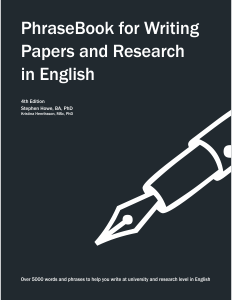The PhraseBook for Writing Papers and Research gives non-native-speaking researchers a bank of over 5000 words and phrases to help write, present and publish in English. Phrases are divided into around 30 main sections that follow the structure of university and research writing, such as Introducing a Study, Defining the Scope of a Study, Arguing For and Against, Reviewing Other Work, Summarizing and Conclusions. Many sections are further divided, for example the Relationship to previous work, Contrasting work and the Limitations of current knowledge.
In addition, Writing Help sections give advice on university and research writing in English. Main chapters include Style, Spelling, Punctuation, Grammar, Vocabulary, Numbers and Time. These include subsections on for example Referring to yourself, British and US spellings, Punctuating quotations, and References. The Writing Help sections help writers avoid many common errors in English. The PhraseBook also has a University and Research Thesaurus to help improve academic vocabulary, as well as a Glossary of University and Research Terminology. It further includes exercises for self-study and guides for using the PhraseBook in the classroom.
Click here download a sample PDF or view online. The PhraseBook sample PDF is in the top 0.5% of viewed publications on Academia.edu (Sept. 2014).
‘this material, prepared by experienced editors, is certainly very useful’
Photosynthetica
‘this book has been designed to help nonnative speakers write…in English’
The Daily Yomiuri, Japan
The Kindle version of the PhraseBook is a Top 100 Best Seller on Amazon.com in Science Education Research (March 2014).
The PhraseBook is used in over 30 countries in subjects ranging from Medicine, Engineering, Science and Technology to Law, Business and Economics, Political Science, Geography, History, Sociology, Psychology, Language and Education.
Users of the PhraseBook include academic staff, students and researchers at universities such as Oxford University, the University of Geneva, the University of Tokyo, the Chinese Academy of Sciences, the Universidad de Buenos Aires, Stanford University and the University of California at Berkeley, as well as at organizations such as the Medical Nobel Institute and companies from pharmaceuticals to space technology.
The PhraseBook is available in paperback at Amazon, as well as on Kindle, Apple iBooks and Google Play.
A number of example phrases are given below:
Introducing your work
The study will begin by outlining…
This study addresses a number of issues…
Chapters X and X concentrate on…
The following section sets out…
…to examine the research problem in detail
…to shed light on a number of problem areas in current theory
The paper presented here is based in part on an earlier study
Defining the scope of your study
The focus of the study is…
The central question to be examined in this paper is…
The study is important for a number of reasons:
Present understanding of…is limited.
Many authors would agree that…
Previous studies have shown or suggested that…
The problem has been much discussed in recent literature.
This approach has a number of advantages: firstly,…
The present study was designed to test the hypothesis that…
A fuller discussion of…will appear in a later publication.
Arguing for and against
This point is particularly relevant to…
This becomes clear when one examines…
This lends weight to the argument that…
Support for this interpretation comes from…
To put it another way,…
This raises the question whether…
While it may well be valid that…, this study argues the importance of…
This begs the question why…
A serious drawback of this approach is…
One of the prime failings of this theory or explanation is…
Reviewing other work
X’s study is a textbook example of…
X’s work has had a profound influence on…
The study contains a number of new and important insights:
X makes a strong case for…
X takes little or no account of…
There is little evidence to suggest that…
It is very much an oversimplification to…
The study offers only cursory examination of…
X gives a detailed if not always tenable analysis of…
The authors’ claim that…is not well founded.
X’s explanation is not implausible, if not entirely satisfactory.
Analysis and explanation
One tentative proposal might be that…
If, for the sake of argument, we assume…
One of the most obvious consequences of…is…
This would appear to be supported by…
There is some evidence to suggest that…
The importance of…is demonstrated clearly by…
Although it may well be true that…, it is important not to overlook…
It is important to distinguish carefully between…
It is not necessarily the case that…
The extent to which this reflects…is unclear.
A more plausible explanation for or of…would…
The reason for…is unknown, but…has been suggested by X as a possible factor.
Summary and conclusions
Concluding this section, we can say that…
Chapter X draws together the main findings of the paper.
The study has gone some way towards understanding…
A number of key issues have been addressed in this study.
The results lend strong support to…
This study has highlighted a number of problem areas in existing theory.
While the initial findings are promising, further research is necessary.
This raises a number of questions for future research.
The results of this study suggest a number of new avenues for research.
